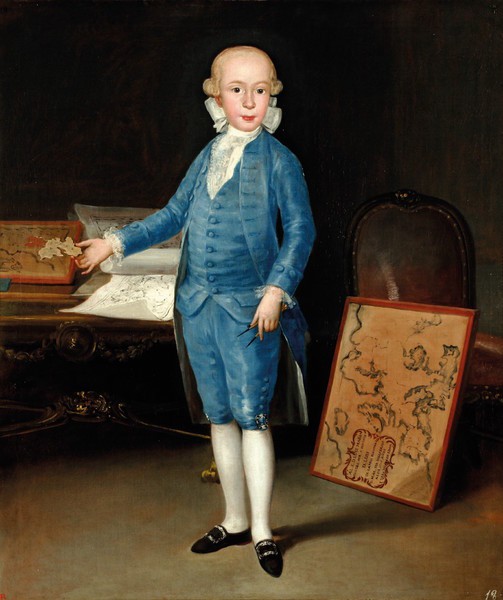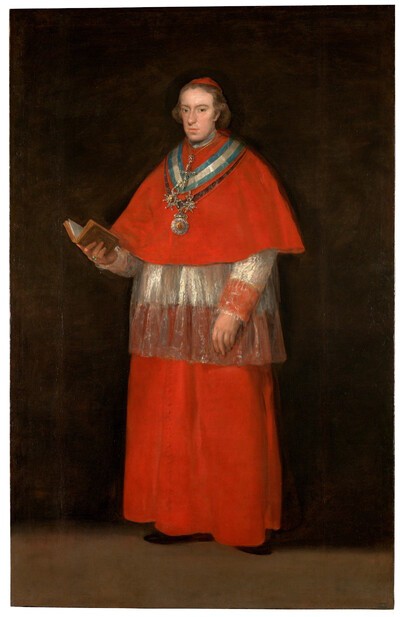- Cronología
- 1783
- Ubicación
- Museum of Zaragoza, Zaragoza, Spain
- Dimensiones
- 134 x 113 cm
- Técnica y soporte
- Oil on canvas
- Reconocimiento de la autoría de Goya
- Documented work
- Titular
- PLAZA Foundation
- Ficha: realización/revisión
- 18 Jan 2010 / 11 Dec 2024
- Inventario
- en depósito
- Otros títulos:
-
Portrait of Don Luis María, as a Child, Studying Geography (Retrato de don Luis María, niño, estudiando Geografía)
Al S. S. Luis María, Hixo del Ser. Infante D. Luis y de la muy ilustre S. D. Mar. Ter. Vallabriga, a los seis años y tres meses de edad ("To His Highness the Señor Infante Don Luis María, son of the Señor Infante Don Luis and her Highness the Señora Doña María Teresa de Vallabriga, at the age of six years and three months", on the map to the left, on the chair).
This work was commissioned by the Infante Luis Antonio Jaime de Bourbon. It has subsequently belonged to a number of different collections: that of Arenas de San Pedro (Ávila), 1783-1785; Boadilla del Monte (Madrid), 1785-1797; María Teresa de Vallabriga (1797-1820); María Teresa de Bourbon y Vallabriga (1820-1828); Carlota Luisa de Godoy y Bourbon (1828-1886); Alfonso Ruspoli y Godoy (1886-1914); Carlos Luis Ruspoli (1914-1936); and María del Rosario Ignacia Álvarez de Toledo Ruspoli, Marchioness of Pontejos (1943-2006). It was acquired in 2006 by the PLAZA Foundation and deposited that same year in the Museum of Zaragoza.
From December 5th, 2024, and while the Zaragoza Museum remains closed for works, the painting is part of the exhibition 'Goya. From the Museum to the Palace' in the Aljafería Palace in Zaragoza.
Luis María de Bourbon y Vallabriga (Cadalso de los Vidrios, Madrid, 1777-Madrid, 1823) was the son of the Infante Don Luis de Bourbon, brother of Charles III, and María Teresa de Vallabriga. From an early age he received a careful upbringing and education from great teachers, with whom he studied subjects which included geography, mathematics and natural sciences, as well as music and dance. Later on, his uncle Charles III sent Luis María to study in Toledo under the tutelage of a humanist cleric. There, the boy lived in the archbishop's palace and began to take an interest in the affairs of the Church, finally deciding to become a priest. He reached the rank of Archbishop of Seville in 1799 and was later designated cardinal by Pope Pius VII in 1800.
The portrait depicts the infante at the age of six, in the centre of the composition, inside a room (a study room). He is standing and his body is turned slightly to the right, whilst his head is looking straight out at the viewer. He is wearing court dress, with white shirt and stockings, a waistcoat, dress coat and trousers of a striking Prussian blue (indicating his belonging to a royal family). His clothes are decorated with lace frills at the cuffs and chest, as well as a large bow used to tie back his hair at the back of his neck and buckles both on the trousers and on his red, heeled shoes, a discrete reference to his noble standing. In his right hand he holds a piece of a geographical jigsaw puzzle, whilst with the other he holds a pair of compasses. Behind him and on the right-hand side of the composition are an armchair, against which a framed map of Europe rests, and which bears the inscription shown above. On the other side is a carved table decorated in gold, on top of which are laid out various paper maps and the jigsaw puzzle that the infante is about to finish. The infante's face stands out sharply against the neutral background, and is given even greater presence and a perceived proximity to the viewer thanks to the cold colours of his clothing.
Goya went on to paint Luis María de Bourbon y Vallabriga on two subsequent occasions, full length and dressed as cardinal, these two works today being found in the São Paulo Museum of Art (Brazil) and the Prado Museum, Madrid.
The work formed a pair with another, depicting the subject's sister,María Teresa de Bourbon y Vallabriga, future Countess of Chinchón, in a garden and with a natural landscape in the background (National Gallery of Art, Washington, USA).
The condition of the painting prior to its restoration was reasonably good. However, small losses of material had occurred in the painting over time, affecting different areas of the surface, and caused by the craquelure in the paint layer.
The painting was restored at the Prado Museum in 2006.
-
Luis María de Borbón y VallabrigaMuseo de ZaragozaZaragoza2007organized by Fundación Goya en Aragón at the Museo de Zaragoza, consultant editors María Luisa Arguís and Miguel Beltrán Lloris. From September 25th 2007 to January 8th 2008cat. 10
-
Goya e ItaliaMuseo de ZaragozaZaragoza2008organized by the Fundación Goya en Aragóna, consultant editor Joan Sureda Pons. From June 1st to September 15th 2008cat. 272
-
Goya y el infante don Luis: el exilio y el reino.Palacio Real, MadridMadrid2012Arte y ciencia en la época de la ilustración española. Responsable científico Francisco Calvo Serraller. Del octubre de 2012 a enero de 2013.cat. 19
-
Goya: Order and disorderMuseum of Fine ArtsBoston2014cat. 46
-
Goya: The PortraitsLondon2015cat. 7
-
Goya. From the Museum to the PalaceZaragoza2024cat.121
-
L'œuvre peint de Goya. 4 volsParís1928-1950vol. II, p.14, cat. 293
-
Vie et ouvre de Francisco de GoyaParísOffice du livre1970p. 94, cat. 209
-
BarcelonaPolígrafa1970vol. I, p. 258, cat. 149
-
Francisco de Goya, 4 vols.ZaragozaCaja de Ahorros de Zaragoza, Aragón y Rioja1980-1982vol. I, p. 151 y 273 (il.)
-
La infanta María Teresa de Vallabriga en Zaragoza y su colección de pintura y alhajasRevista ArtigramaZaragoza2001pp.421-439
-
Pinturas que poseyó el infante don Luis en la colección de Patrimonio Nacional (1845-1850)GoyaMadrid2005
-
Luis María de Borbón y Vallabriga. Francisco de GoyaZaragozaGobierno de Aragón, Dpto. de Educación, Cultura y Deporte2007cat. 10
-
Goya e Italia, 2 vols.ZaragozaFundación Goya en Aragón y Turner2008pp. 298-299 (il.), cat. 272
-
Goya y el infante don Luis de Borbón (Homenaje a la “Infanta” María Teresa de Vallabriga)ZaragozaIbercaja1996p.27
-
Goya: Order & DisorderBostonMuseum of Fine Arts Boston Publications2014pp. 110-111
-
LondonNational Gallery Company2015pp. 43-44
-
Goya. From the Museum to the PalaceZaragozaZitro Comunicación2024pp.120-121


